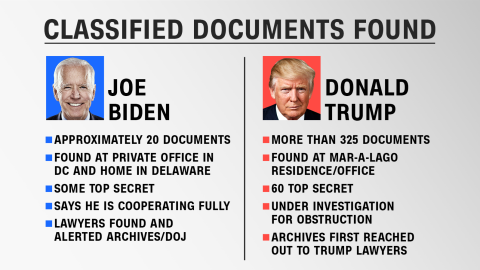
This is getting absurd.
Americans have had the opportunity to choose from between three people to be president since 2016, and all three have been found to have classified documents they should not have.
Clearly, there’s a larger problem.
Here’s what we don’t know:
We, the public, don’t know what documents President Joe Biden had locked up in his garage or in the manila folder in his Penn Biden Center office.
We don’t know specifics about what documents the FBI photographed on the floor at former President Donald Trump’s Mar a Lago resort.
We don’t even know for sure what documents were on Hillary Clinton’s email server, although we do know that dozens of those documents were retroactively classified years after the fact, long after the existence of her private email server became a political albatross.

Here’s what we do know:
Classified documents, and their appearance in email, offices, a storage room and a garage, have created political headaches for successive presidential candidates from both parties.
The classification system utilized by the US government is siloed into separate organizations, impossible to follow, and not uniformly applied.
I tried and failed on Sunday to find a written estimate of how much classified information the government produces each year.
A fascinating Twitter thread by the former CIA lawyer Brian Greer explains that most of the information classified by the government is put under classification by default, as a “derivative classification decision.”
He links to a 2016 estimate from the Information Security Oversight Office at the National Archives that estimates that in that year alone, there were more than 102 million pages of US government documents reviewed for declassification and about 44 million pages were declassified.
That means most of what the government could declassify that year, it didn’t.
Thousands of rule books.
A more recent report by the same agency outlines that there are 2,116 distinct “security classification guides” by which different government agencies classify documents. The Archives argues these should be assessed and streamlined in a comprehensive way that still acknowledges the different needs of the 18 distinct US intelligence agencies.
More than a million people have top-secret clearance.
As I wrote back in August, it’s actually a very large universe of people with access to Top Secret data. The director of national intelligence publishes what is described as an annual report, “Security Clearance Determinations,” although the most recent one I could find was from 2017. In it, more than 2.8 million people are described as having security clearance as of October 2017 – more than 1.6 million have access to either Confidential or Secret information and nearly 1.2 million are described as having access to Top Secret information.
There are additional people who have security clearance but don’t currently have access to information. This includes civilian employees, contractors and members of the military.
Overclassification, defined.
There are so many examples of information the government kept classified long after it was necessary. Take the documents related to the JFK assassination, 60 years ago, that were released just last month by the CIA. Or, as The Washington Post notes in an editorial, the silly fact that President George W. Bush and Vice President Dick Cheney’s interviews with the 9/11 commission were kept under wraps for 18 years. The Post editorial board outlines some recommendations, including perhaps deleting the lowest-tier of classification, “confidential.”
Admitting there’s a problem.
Back in June, before revelations about his or Trump’s improper or accidental keeping of classified documents, Biden’s White House initiated a systemic review of the classification system.
That came after a request from senators who complained that the classification system costs taxpayers $18.5 billion per year, according to The Wall Street Journal.
The Journal also reported on a letter the director of national intelligence, Avril Haines, wrote back to the senators in which she said overclassification is a national security threat.
“It is my view that deficiencies in the current classification system undermine our national security, as well as critical democratic objectives, by impeding our ability to share information in a timely manner,” she said.
Shortly thereafter the Biden administration proved that sharing information can be beneficial when it began declassifying information to make the world aware that Russia was planning to invade Ukraine.
No one is suggesting there should be no classified information.
The identities and methods of people who obtain intelligence should be secret. The specifics of nuclear capabilities and other similarly sensitive material should be secret.
But it’s also important to recognize that top people in the government and the intelligence community agree that the government keeps too many secrets.




